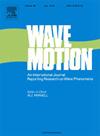Energy velocity of elastic guided waves in immersed plates for complex frequencies and slownesses
IF 2.5
3区 物理与天体物理
Q2 ACOUSTICS
引用次数: 0
Abstract
The computation of guided modes in fluid-loaded multilayer plates is generally done by a spatial approach, i.e. solutions are sought for a complex slowness. An alternative approach, less frequently employed, involves seeking solutions for complex frequencies. These frequencies correspond to plate resonances. They denote transient phenomena and the guided modes exhibit non-harmonic behavior. Consequently, conventional methods of averaging over time periods become unsuitable for calculating the means of energy quantities. In other words, the calculation of average fields cannot be reduced to a single average over a time period. To tackle this issue, for a predetermined mode, the average fields are obtained through a single averaging process applied to an arbitrary phase term. This averaging process renders independent the means of all energy quantities from the arbitrary origin phase. As usual, an additional integration across the thickness is conducted to derive total energy quantities. Doing this, the total average fields depend on both time and position on the surface plate. A set of four equations is derived from instantaneous and local energy balance equations. From these averages, the energy velocity can be directly calculated. The equations provide further insights into wave dispersion and damping along the energy flow direction, arising from viscoelastic losses and leakages in fluid.
复频率和慢度下沉板中弹性导波的能量速度
流载多层板导模的计算一般采用空间方法,即对复杂慢度求解。另一种不太常用的方法是寻找复频率的解。这些频率对应于平板共振。它们表示瞬态现象,并且导模表现出非谐波行为。因此,按时间段平均的传统方法不适合计算能量的平均值。换句话说,平均字段的计算不能简化为一段时间内的单个平均值。为了解决这个问题,对于预定模式,通过对任意相位项进行一次平均处理获得平均场。这种平均过程使任意起始阶段的所有能量的平均值独立。像往常一样,在厚度上进行额外的积分以得出总能量。这样做,总平均场取决于时间和在表面板上的位置。由瞬时能量平衡方程和局部能量平衡方程推导出一组四个方程。从这些平均值可以直接计算出能量速度。这些方程进一步揭示了由流体中的粘弹性损失和泄漏引起的沿能量流动方向的波色散和阻尼。
本文章由计算机程序翻译,如有差异,请以英文原文为准。
求助全文
约1分钟内获得全文
求助全文
来源期刊

Wave Motion
物理-力学
CiteScore
4.10
自引率
8.30%
发文量
118
审稿时长
3 months
期刊介绍:
Wave Motion is devoted to the cross fertilization of ideas, and to stimulating interaction between workers in various research areas in which wave propagation phenomena play a dominant role. The description and analysis of wave propagation phenomena provides a unifying thread connecting diverse areas of engineering and the physical sciences such as acoustics, optics, geophysics, seismology, electromagnetic theory, solid and fluid mechanics.
The journal publishes papers on analytical, numerical and experimental methods. Papers that address fundamentally new topics in wave phenomena or develop wave propagation methods for solving direct and inverse problems are of interest to the journal.
 求助内容:
求助内容: 应助结果提醒方式:
应助结果提醒方式:


